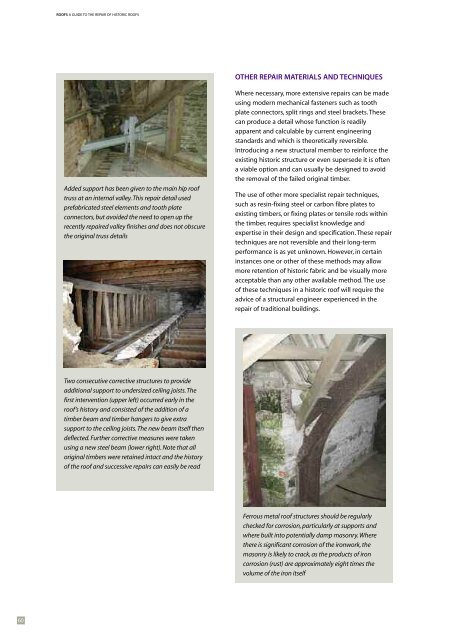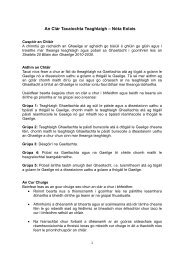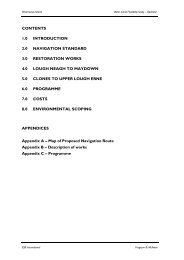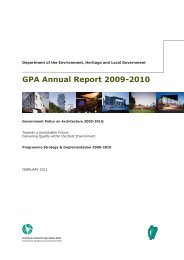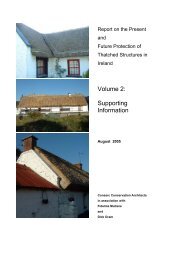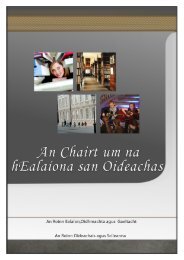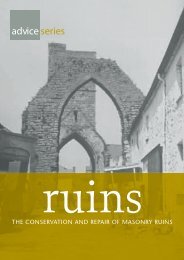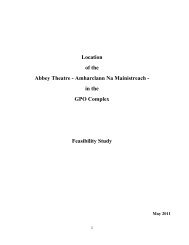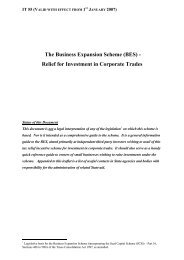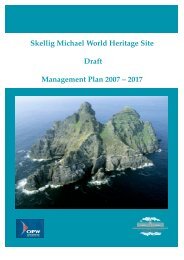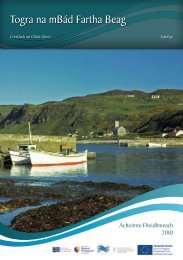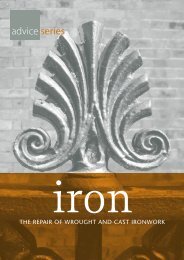A Guide to the Repair of Historic Roofs - Dublin City Council
A Guide to the Repair of Historic Roofs - Dublin City Council
A Guide to the Repair of Historic Roofs - Dublin City Council
You also want an ePaper? Increase the reach of your titles
YUMPU automatically turns print PDFs into web optimized ePapers that Google loves.
ROOFS A GUIDE TO THE REPAIR OF HISTORIC ROOFSOTHER REPAIR MATERIALS AND TECHNIQUESAdded support has been given <strong>to</strong> <strong>the</strong> main hip ro<strong>of</strong>truss at an internal valley. This repair detail usedprefabricated steel elements and <strong>to</strong>oth plateconnec<strong>to</strong>rs, but avoided <strong>the</strong> need <strong>to</strong> open up <strong>the</strong>recently repaired valley finishes and does not obscure<strong>the</strong> original truss detailsWhere necessary, more extensive repairs can be madeusing modern mechanical fasteners such as <strong>to</strong>othplate connec<strong>to</strong>rs, split rings and steel brackets. Thesecan produce a detail whose function is readilyapparent and calculable by current engineeringstandards and which is <strong>the</strong>oretically reversible.Introducing a new structural member <strong>to</strong> reinforce <strong>the</strong>existing his<strong>to</strong>ric structure or even supersede it is <strong>of</strong>tena viable option and can usually be designed <strong>to</strong> avoid<strong>the</strong> removal <strong>of</strong> <strong>the</strong> failed original timber.The use <strong>of</strong> o<strong>the</strong>r more specialist repair techniques,such as resin-fixing steel or carbon fibre plates <strong>to</strong>existing timbers, or fixing plates or tensile rods within<strong>the</strong> timber, requires specialist knowledge andexpertise in <strong>the</strong>ir design and specification. These repairtechniques are not reversible and <strong>the</strong>ir long-termperformance is as yet unknown. However, in certaininstances one or o<strong>the</strong>r <strong>of</strong> <strong>the</strong>se methods may allowmore retention <strong>of</strong> his<strong>to</strong>ric fabric and be visually moreacceptable than any o<strong>the</strong>r available method. The use<strong>of</strong> <strong>the</strong>se techniques in a his<strong>to</strong>ric ro<strong>of</strong> will require <strong>the</strong>advice <strong>of</strong> a structural engineer experienced in <strong>the</strong>repair <strong>of</strong> traditional buildings.Two consecutive corrective structures <strong>to</strong> provideadditional support <strong>to</strong> undersized ceiling joists. Thefirst intervention (upper left) occurred early in <strong>the</strong>ro<strong>of</strong>’s his<strong>to</strong>ry and consisted <strong>of</strong> <strong>the</strong> addition <strong>of</strong> atimber beam and timber hangers <strong>to</strong> give extrasupport <strong>to</strong> <strong>the</strong> ceiling joists. The new beam itself <strong>the</strong>ndeflected. Fur<strong>the</strong>r corrective measures were takenusing a new steel beam (lower right). Note that alloriginal timbers were retained intact and <strong>the</strong> his<strong>to</strong>ry<strong>of</strong> <strong>the</strong> ro<strong>of</strong> and successive repairs can easily be readFerrous metal ro<strong>of</strong> structures should be regularlychecked for corrosion, particularly at supports andwhere built in<strong>to</strong> potentially damp masonry. Where<strong>the</strong>re is significant corrosion <strong>of</strong> <strong>the</strong> ironwork, <strong>the</strong>masonry is likely <strong>to</strong> crack, as <strong>the</strong> products <strong>of</strong> ironcorrosion (rust) are approximately eight times <strong>the</strong>volume <strong>of</strong> <strong>the</strong> iron itself60


